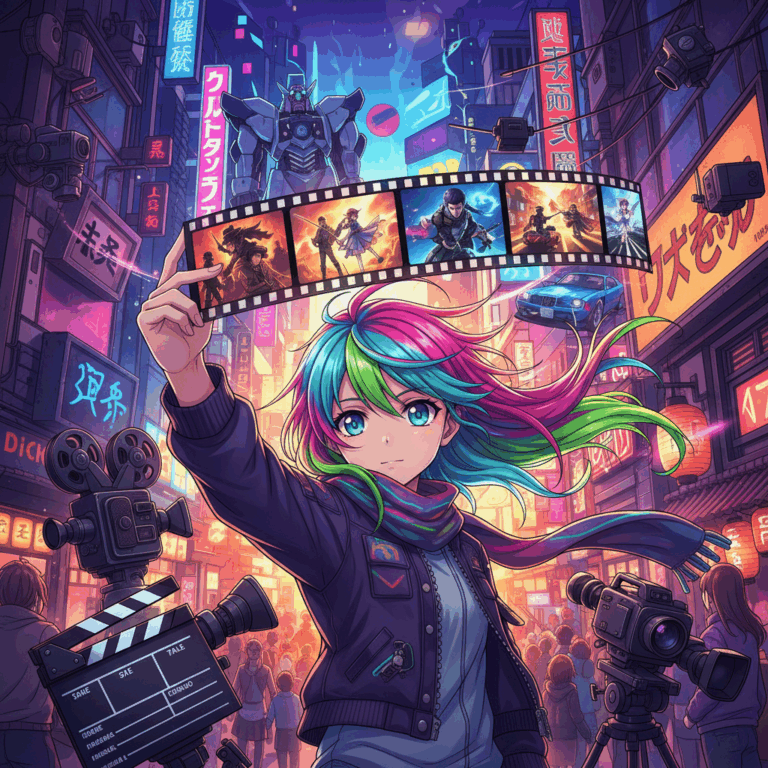Featured Japanese animated films
Japanese animated cinema is recognized worldwide for its artistic and narrative qualityThese films offer a diversity of styles and themes that deeply impact fans.
Iconic titles have marked historically the genrecreating cultural legacies that transcend generations and borders. Their influence can be seen in the globalization of anime.
Among its main contributions are technical innovation and the exploration of complex realities, which makes this cinema a unique visual and emotional experience.
Landmark works and their cultural impact
Films like "Spirited Away" and "Akira" are landmarks that changed the world's perception of anime. Their success has boosted the recognition of Japanese cinema.
These works blend mythology, science fiction, and social criticism, generating a cultural impact that goes beyond entertainment, influencing fashion, art, and global narrative.
In addition, narratives such as those in "Grave of the Fireflies" and "My Neighbor Totoro" introduce profound emotional themes, bringing the audience closer to reflections on life, war, and nature.
Themes and techniques in Japanese animation
Japanese animation encompasses themes ranging from pure fantasy to psychological drama, using innovative techniques that combine traditional drawing and digital technology.
The directors explore complex worlds with detailed strokes and an expressive color palette that delves into the atmosphere of each story, intensifying the viewer's experience.
This tonal and visual diversity allows for addressing sensitive topics such as war, disability, and human relationships, giving richness and variety to the genre.
Live-action films based on anime and manga
Live-action films have gained popularity by adapting successful manga and anime, attracting both fans and new audiences.
These productions expand the original universes, offering a different perspective with real actors and tangible settings.
Live-action represents a way to experience classic stories with a new visual and narrative dimension.
Successful adaptations and their popularity
Films such as “Rurouni Kenshin” and “Assassination Classroom” have been acclaimed for capturing the spirit and essence of their original works.
The success of these adaptations lies in respecting the plot and characters, while offering visual effects that impact the viewer.
These films appeal to both anime fans and those who enjoy action and drama films, expanding their audience.
Challenges in translating anime to live action
Translating the unique aesthetic of anime to real actors and settings is a challenge, as it involves adapting very specific visual and narrative styles.
Sometimes, the complexity of the fantastical or stylized elements makes fidelity difficult and generates criticism among fans.
However, achieving a balance between authenticity and creativity is key to the success and acceptance of these productions.
Iconic titles and thematic diversity
Besides “Rurouni Kenshin”, titles like “Kingdom” and “Death Note” show the variety of genres that live-action covers, from action to psychological thriller.
This diversity allows for the exploration of different universes, from feudal Japan to futuristic or school settings, expanding the scope of anime.
Thus, live-action positions itself as a vital complement for fans who want new experiences within their favorite stories.
Value and reception of both formats
Animated and live-action films bring different dimensions to the anime universe, enriching the viewer's experience.
Both formats summarize and expand the original worlds, offering new insights and highlighting different narrative and visual aspects.
The interaction between animation and live action allows fans to enjoy their favorite stories from complementary perspectives.
How they complement the anime experience
The animation maintains the visual and narrative essence of anime, highlighting its unique style and thematic depth, which strengthens the emotional connection.
Live-action, on the other hand, translates that world into a more tangible context, allowing us to see characters and environments with real actors and practical effects.
This combination expands the forms of artistic and narrative experimentation, offering a more complete and dynamic experience to viewers.
By combining both formats, fans can explore the stories from different perspectives, enriching their understanding and enjoyment.
Importance for anime fans
Japanese films, both animated and live-action, are essential for anime fans because they broaden their understanding and enjoyment of their favorite universes.
Through these productions, fans can explore new angles and delve deeper into stories that complement and expand upon the original narratives.
This enriches the experience beyond the series, adding visual and narrative dimensions that strengthen the connection with the genre.
Exploration of universes and new perspectives
Films allow fans to experience familiar stories from different perspectives, exploring details and characters that the original format doesn't always manage to show.
Furthermore, these films often open doors to expanded or reinterpreted worlds, offering creative innovations that keep interest in the franchise alive.
This in-depth exploration strengthens the emotional connection with the works, providing them with added value and greater narrative complexity.
Thus, fans enjoy novel experiences that complement what is already known, maintaining a constant fascination with anime.
Narrative and visual enrichment of the genre
Japanese films offer superior visual and technical quality that in many cases surpasses television broadcasts, achieving a significant artistic impact.
In terms of narrative, they allow for the development of more in-depth plots, exploring complex emotions and conflicts that enrich the genre and its scope.
This enrichment helps fans recognize animation and live-action as robust and mature forms of cultural expression.






